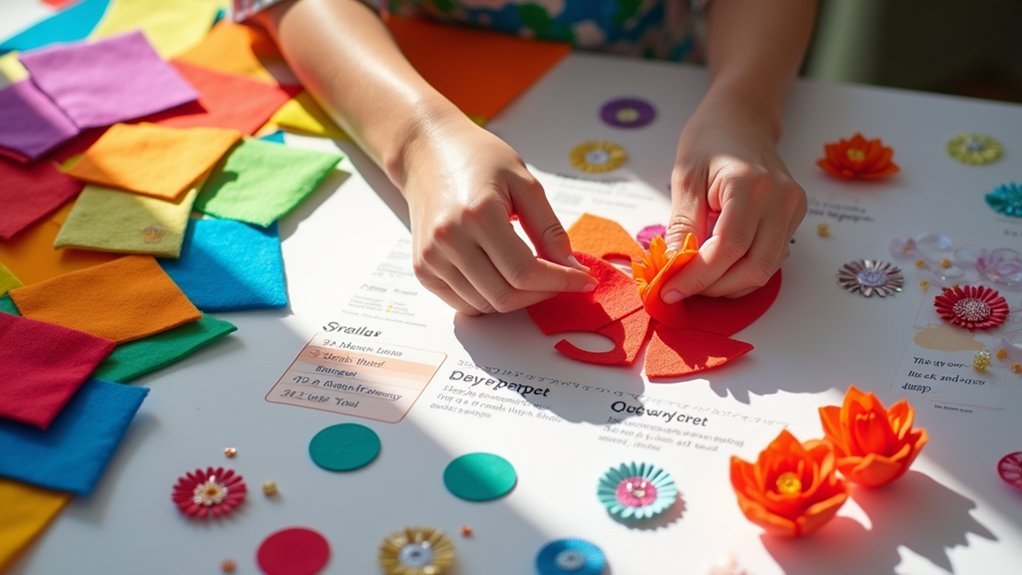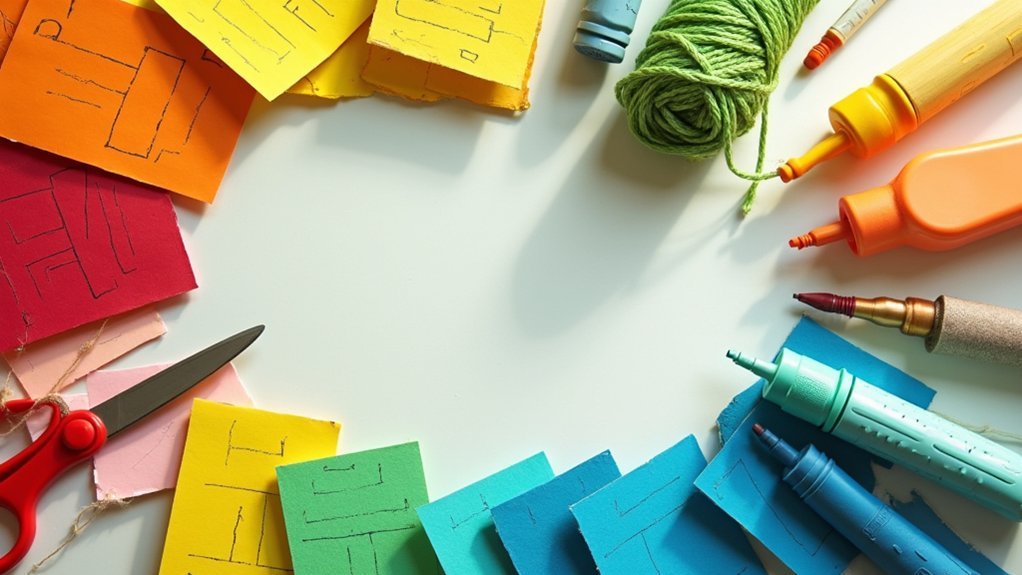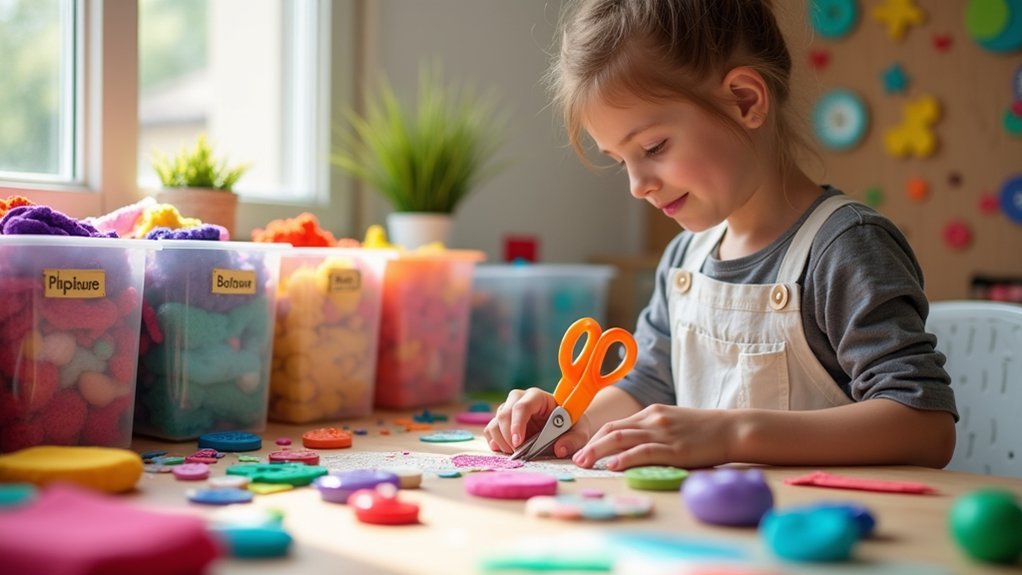Dyslexia-friendly crafting focuses on visual instructions, multi-sensory techniques, and color-coded steps rather than text-heavy directions. You’ll find success with simple materials like popsicle sticks, salt dough, and sensory slimes that build confidence through tactile experiences. Try projects with built-in adaptability like Popsicle Stick Snowflakes or Christmas Candy Pots that don’t require complex reading. These approaches create an inclusive crafting environment where creativity flourishes regardless of reading challenges. Discover how these techniques can transform your DIY experience below.
Visual Craft Instructions: Using Pictures Instead of Words

While traditional craft instructions often rely heavily on written directions, visual instructions provide an essential alternative for dyslexic makers. Clear images and diagrams replace text, considerably reducing reading challenges while enhancing comprehension.
Step-by-step pictures allow you to follow along at your own pace, fostering independence in crafting activities. Icons and symbols simplify complex processes, making each step easier to understand and execute. Color-coded visuals help organize materials and tools, providing additional cues that strengthen memory retention during project completion.
These visual craft instructions create a more inclusive learning environment by engaging multiple senses. For those with dyslexia, this approach transforms potentially frustrating experiences into enjoyable creative outlets.
You’ll find yourself confidently completing projects that might otherwise seem intimidating with text-heavy instructions.
Multi-Sensory Crafting Techniques for Better Learning
Because traditional crafting often relies on just one or two senses, multi-sensory crafting techniques offer dyslexic makers a more complete learning experience. When you engage multiple senses simultaneously, you’ll strengthen neural connections and improve memory retention.
Try incorporating textured materials like play dough or fabric scraps into your projects, creating a hands-on experience that reinforces concepts through touch. Add auditory elements by clapping rhythms or singing while crafting to enhance phonological awareness.
Use visual aids such as color-coded supplies or simple diagrams to support your organizational skills and help follow instructions.
Don’t forget to incorporate movement—reach, stretch, or even dance while creating to stimulate cognitive processes.
These interactive approaches transform ordinary crafting into powerful learning opportunities for dyslexic learners, making the creative process more enjoyable and effective.
Color-Coded Project Steps for Easier Following

When project instructions become overwhelming, color-coding transforms the experience for dyslexic makers. Assign bright, contrasting colors to different stages of the crafting process—use blue for preparation tasks, green for assembly steps, and orange for decoration elements. This visual organization reduces cognitive load and helps you follow sequential instructions with confidence.
Enhance your color-coded system by adding visual symbols alongside text. A scissors icon with red instructions signals cutting, while a paintbrush with purple text indicates decorating. This combination improves comprehension and retention of each step.
Try implementing this multisensory approach using colored paper, markers, or stickers to organize your materials. You’ll engage multiple learning pathways while expressing your creativity—making crafting both accessible and enjoyable.
Simple Materials That Build Confidence and Skills
The magic of crafting for dyslexic makers lies in starting with simple, accessible materials that produce rewarding results. When you work with mini terracotta pots or salt dough, you’re providing tangible outcomes that build confidence through achievable goals.
Basic supplies like glue, scissors, and crayons enable independence without overwhelming instructions. Try decorating popsicle stick snowflakes or creating Santa slime—these activities develop fine motor skills in a low-pressure environment while minimizing reading requirements.
Focus on collaborative projects that encourage social skills and family bonding. These simple materials allow dyslexic makers to express creativity without traditional learning barriers.
The beauty of these crafts is that they shift attention from reading challenges to problem-solving abilities, helping your child develop skills while experiencing genuine pride in their completed work.
Adaptable Crafts With Built-In Success Features

Successful crafting experiences for dyslexic makers depend heavily on projects with built-in adaptability and assured success. Popsicle Stick Snowflakes offer simple assembly without complex reading requirements, allowing you to focus on creativity rather than instructions.
Salt Dough ornaments provide a forgiving medium that can be easily shaped with cookie cutters, building confidence through tactile learning.
You’ll find that Christmas Candy Pots let you incorporate various materials without pressure, while non-toxic glue guarantees safety during hands-on activities.
Consider crafts with sensory elements like Santa Slime, which enhances engagement through touch. These adaptable crafts support creative expression while minimizing frustration.
The best projects for dyslexic makers include built-in success features that celebrate your unique strengths and foster achievement regardless of reading challenges.
Frequently Asked Questions
What Crafts Are Good for Kids With Dyslexia?
You’ll find that Christmas Candy Pots, Popsicle Stick Snowflakes, Salt Dough Ornaments, Santa Slime, and Gingerbread Cookies are perfect crafts. They require minimal reading and use visual instructions that won’t frustrate you.
What Activities Are Dyslexics Good At?
If you’re dyslexic, you’ll often excel at visual-spatial activities like art, hands-on crafts, and building projects. You’re likely to thrive in movement-based hobbies, design work, and collaborative tasks requiring creative problem-solving skills.
What Hobbies Are Dyslexics Good At?
You’ll excel at visual arts, hands-on crafts, and creative pursuits that leverage your strong spatial skills. Try painting, woodworking, pottery, music, coding, or storytelling—activities where your unique thinking style becomes a distinct advantage.
What Color Is Best for Dyslexia?
There’s no single “best” color for dyslexia. You’ll typically find blue, yellow, or green overlays helpful, but it’s personal. Try different pastel shades and high-contrast combinations to discover what reduces your visual stress most effectively.
In Summary
You’ve now got a toolbox of dyslexia-friendly crafting techniques that work with your strengths. Remember, it’s not about avoiding text—it’s about finding your own creative path. Whether you’re following color-coded instructions, engaging multiple senses, or adapting projects to fit your needs, you’re building more than crafts—you’re building confidence. Keep exploring, creating, and celebrating your unique making style. Your dyslexia isn’t a barrier—it’s just part of your creative journey.





Leave a Reply